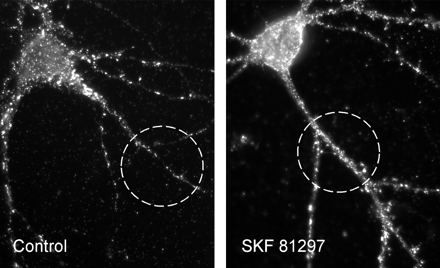
- Institution: Stanford Univ Med Ctr Lane Med Lib/Periodical Dept/Rm L109
- Sign In as Member / Individual
Addiction: Making the Connection Between Behavioral Changes and Neuronal Plasticity in Specific Pathways

Dopamine regulates cell surface AMPA receptor expression. Insertion and removal of AMPA receptors from synaptic sites is important for LTP and LTD (16,17). In cultured nucleus accumbens neurons, D1 dopamine receptor stimulation increased the density of AMPA receptor puncta on the cell surface, suggesting a mechanism by which dopamine might influence LTP and LTD (83). Primary cultures were prepared from nucleus accumbens of postnatal day one rats. AMPA receptors on the cell surface were visualized by incubating live cells (twenty-one days in vitro) with antibody that recognizes the extracellular portion of the AMPA receptor subunit GluR1, fixing cultures, and then incubating with fluorescent secondary antibody. To quantify GluR1 surface expression, a standard length of neurite was defined using a circle 25 μM in diameter and the number of cell surface GluR1 puncta on a single neurite within the circle was counted using MetaMorph Imaging software. Left panel: Control conditions. Right panel: Incubation with the D1 agonist SKF 81297 (1 μM, for fifteen minutes) increased the density of surface GluR1 puncta. Nucleus accumbens interneurons are shown in these pictures, but the same results were obtained for medium spiny neurons, the projection neurons of the nucleus accumbens (83). In the same culture system, D1 receptor stimulation increased phosphorylation of GluR1 at the protein kinase A site, suggesting another way that dopamine may influence basic mechanisms of synaptic plasticity (81).


